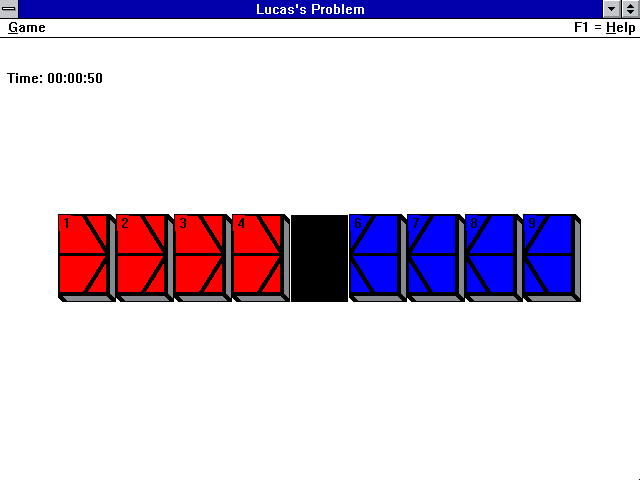Retro Replay Review
Gameplay
Lucas’s Problem takes the classic single‐board reversal puzzle devised by Édouard Lucas and transforms it into a rich, level‐based challenge. Each stage presents a slightly larger board or more restrictive move limits, forcing players to think several moves ahead. The core mechanic—moving a piece one space forward or jumping a single opponent’s piece—remains faithful to the original, but the introduction of timed modes, move counters, and optional hints gives modern players a variety of ways to engage.
(HEY YOU!! We hope you enjoy! We try not to run ads. So basically, this is a very expensive hobby running this site. Please consider joining us for updates, forums, and more. Network w/ us to make some cash or friends while retro gaming, and you can win some free retro games for posting. Okay, carry on 👍)
The user interface is intuitive: simply click or tap on a piece to highlight legal moves, then select the destination square. As you progress, the game gradually introduces obstacles such as blocked cells, immovable barriers, and rotating boards. These additional constraints keep the gameplay fresh and ensure that even veteran puzzle solvers find new challenges. For those who prefer a pure experience, a “Classic Mode” strips away all extras, letting you focus solely on the mathematics of reversal.
Lucas’s Problem also offers a compelling daily‐puzzle feature, where each day presents a unique board layout with a global leaderboard. This competitive element adds replay value, as players race against the clock or strive for the fewest moves. Achievements—such as solving under ten moves or completing a board blindfolded (without hint reveals)—encourage mastery and exploration of advanced strategies.
In terms of difficulty balance, the game caters to everyone from beginners to seasoned puzzlers. Early levels include built‐in guidance and optional tutorials that explain jump patterns and show sample solutions step by step. Later levels, by contrast, can be fiendishly intricate, demanding precise foresight and sometimes multiple restarts. Overall, Lucas’s Problem nails the sweet spot between accessibility and depth.
Graphics
Visually, Lucas’s Problem opts for a clean, minimalist aesthetic. The board is set against a subtly textured background, and the colored pieces—traditionally black and white—are rendered in vibrant, slightly translucent hues that pop on both bright and dark display modes. Animations are smooth and uncluttered, with satisfying glides and snaps whenever a piece slides or leaps over another.
Though the game’s focus is logic rather than spectacle, small polish touches—like particle effects on successful jumps and a gentle “click” sound on piece selection—add to its tactile appeal. The UI elements, including move counters and timers, are semi‐transparent overlays that don’t distract from the main board. Colorblind‐friendly palettes and adjustable contrast make the experience inclusive for a wide audience.
Loading times are virtually non‐existent, and transitions between levels feature subtle fades rather than jarring cuts. On mobile devices, touch controls feel responsive, with generous hit boxes ensuring precise input even on smaller screens. On PC and console, compatibility with controllers and mouse/keyboard setups is seamless, though purists may prefer the tactile immediacy of touch or mouse-driven play.
Story
Unlike narrative‐heavy titles, Lucas’s Problem weaves its “story” through historical notes and unlockable journal entries. As players advance, they uncover short vignettes about Édouard Lucas’s life in 19th‐century France, his fascination with recreational mathematics, and the origins of the reversal puzzle. These snippets provide context and a sense of progression without interrupting the flow of gameplay.
Between sets of levels, the game occasionally introduces fictionalized framing sequences: a young Lucas testing his latest puzzle on skeptical colleagues, or travelers in a steampunk-inspired workshop creating intricate wooden boards. This light storytelling gives personality to otherwise abstract challenges and helps sustain motivation over dozens of puzzles.
For players craving more narrative depth, an optional “Legacy Mode” reimagines each board as a challenge Lucas faced historically, complete with period‐appropriate artwork and diary excerpts. While purely aesthetic, these episodes add a thematic layer that transforms a straightforward puzzle experience into a brief educational journey through mathematical history.
Overall Experience
With its elegant design and thoughtful features, Lucas’s Problem stands out as one of the best digital adaptations of a classic mathematical puzzle. The balance between pure logic and modern enhancements—timed challenges, daily puzzles, and unlockable lore—ensures broad appeal. Casual players can enjoy a relaxing brain‐teaser, while puzzle aficionados will find deep layers of strategy to master.
Performance is rock‐solid across platforms, and the game’s modest system requirements mean it runs smoothly even on older hardware and low‐end mobile devices. Optional hints and adjustable difficulty levels make the learning curve welcoming, without ever compromising the satisfaction of solving a tough puzzle through ingenuity and planning.
Educationally, Lucas’s Problem is a standout. Teachers and parents can use the game to introduce concepts of forward planning, spatial awareness, and basic combinatorics in a playful environment. The inclusion of historical context around Édouard Lucas further enriches the experience, making it both mentally stimulating and culturally informative.
In summary, Lucas’s Problem offers a remarkably polished package that honors its 19th‐century roots while delivering a contemporary gaming experience. Its blend of accessible gameplay, tasteful visuals, and light narrative framing makes it a must‐have for puzzle lovers and anyone seeking a thoughtfully crafted brain‐teaser.
 Retro Replay Retro Replay gaming reviews, news, emulation, geek stuff and more!
Retro Replay Retro Replay gaming reviews, news, emulation, geek stuff and more!





Reviews
There are no reviews yet.